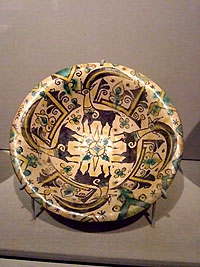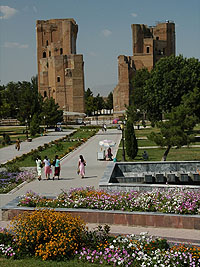 |
|
Uzbekistan - Milestones of History |
|||
|
Using scientific techniques on stone labor instruments and their typology, scientists point to some big cultural periods of that epoch. The largest monuments of the Middle Paleolithic (100000-40000 B.C.) are Ohirakhmat Khojakent, Paltov, Kolbuloq (Tashkent province), Omonqulon, Kuturbuloq, Zirabuloq, Khojamazghil (Samarkand province), and Uchtut (Navoi province). The Teshiktosh cave, discovered in Surkhandarya province in 1938, is a classical example of the Middle Paleolithic. Besides the remains of a fireplace, animal bones, and work tools, the scientists also discovered a Neanderthal boy's burial place alongside the horns of a mountain goat, which served as evidence of some kind of spiritual existence, and probably, religious views of primitive men. The period of Upper Paleolithic (40-30000 to 12-10000 B.C.) is characterized by the development of an early type of modern man, the Cro-Magnon man. The remains of this period are mostly found in Surkhandarya, Samarkand, and Tashkent provinces. The types and forms of labor instruments were further improved by the passing of time. Besides stones, animal bones and wood were also used for their tools. Based on the distribution of labor, generic relationships changed, and patriarchy emerged. Along with that, by that time, primitive men began engaging in the so-called primitive literary handicraft work and drawing by crafting women figurines, various decorations, and primitive writing on the rocks. The period of 12000-5000 B.C. is known as Mesolithic. The mastering of hunting instruments (heads of arrows and spears, and other) and taming of animals were the characteristic features of the period. The people that resided by that time on the territory of Central Asia mostly hunted and fished. More than 100 places were discovered just in the Ferghana Valley pertaining to that period. The time between 6000 and 4000 B.C. is termed as the Neolithic period, or the so-called new Stone Age. Now man improves the techniques of making tools, for grinding, sawing, and drilling. Besides, man began making ceramic tools. And farther, families based on couples began spreading all around at that time. At that time the southern zones of Central Asia are known to have been the settlements of numerous groups along the water basins. The early hunters and fishermen of the time settled on the territories of present day Khorezm and Bukhara oasis. The largest of the researched areas of such remains as Janbas-4 settlement. The remains of a large tent-like dwelling (300 sq. m) has been discovered there, where several families used to stay. The next historical period of 3000 to beginning 1000 B.C. is known as the Bronze Age. Man learned how to produce bronze - a metal much firmer than copper. Numerous Bronze-Age tools such as knives, dashers, work and cosmetic tools, as well as many other items used in everyday life were discovered. Hunting and fishing was gradually replaced by activity in settlements with use of tamed (domestic) animals. Thus, the distant-pasture cattle breeding and agriculture with natural irrigation at first, and further - artificial, becomes the main sphere of man's activity. Three local centers of the ancient agriculture of the Bronze Age were discovered in the south of Uzbekistan. These are the Sherobod, Bandikhon, and Shorchi oasis local centers. In this regard, the so-called Sopollitepa settlement is one of the closely researched physical evidences of that period. The settlement represents a huge countryside-like area with a square fortress at its heart with various types of houses, handicraft, and other structures similar to residential areas inside the fortress. Agriculture based on primitive artificial irrigation, cattle breeding and fishing was the main activity of the local ancient settlers. Ancient kitchenware and other housing tools were discovered to have been made out of clay with further burning at the local workshop. |

